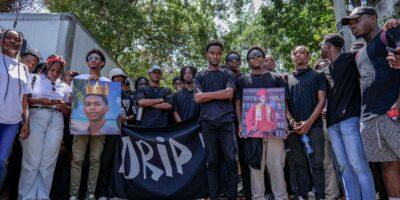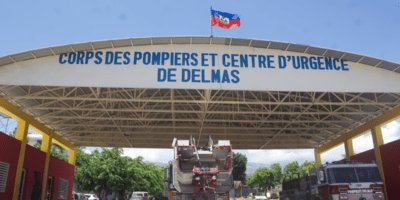The Haina detention center is located on the edge of the Caribbean coast, adjacent to the industrial park and the Refidomsa oil refinery.
Haina, known as the largest detention center for undocumented migrants in the Dominican Republic, has been the subject of much attention since the announcement of mass deportations from the Dominican Republic in early October.
The resort – or Haina Holiday Reception Center – is located in the eponymous town, located in San Cristóbal, in the south of the Dominican Republic.
For years, space officials have been criticized for human rights violations documented by organizations in the neighboring country, including the Human Rights Observatory.
Two lawyers reveal to AyiboPost the workings of this detention center, built in 1977 during the regime of Dominican President Joaquín Balaguer. These professionals defend the rights of migrants in the Dominican Republic and regularly visit the facilities to assist detained people.
Read also: Haitians trapped between mass deportation from the DR and insecurity in Haiti
Haina receives migrants awaiting deportation or document verification. Dominicans deported from abroad are also welcomed there.
The Dominican government wants to deport 10,000 migrants per week.
But “Haina’s holding capacity has been exceeded and the conditions of detention there are inhumane” deplores Vladimir Jojo Fleurimé, a Haitian attorney working in the neighboring country since 2012.
The manager denounces the lack of food, overcrowding, unsanitary conditions, and delays in accessing legal assistance for detained people.
Haina’s holding capacity has been exceeded and the conditions of detention there are inhumane
Once a month, the Promotion d’appui aux immigrants haïtiens et dominicains d’ascendance haïtienne (PAYIDAH), of which Maître Fleurimé is the coordinator, provides humanitarian support to Haitians detained by migration.
“People spend days in Haina without being able to obtain assistance from their families or their lawyers,” Fleurimé explains to AyiboPost.
There are no official figures on the number of people detained in this center.
Foreigners arrested in the east of the country, in Santo Domingo, San Cristobal, Bani, San Pedro de Macoris, and other towns are sent to this center, according to Carlos Sánchez Diaz, a Dominican lawyer and human rights defender based in the town of Haina.
According to Sánchez Diaz, who has worked in this city for more than 20 years, the complex, measuring 25,000 to 30,000 square meters, today includes two academic facilities: Pura Rijos and the Polytechnic Institute of Haina (IPHA). These institutions together welcome more than 500 students.
People spend days in Haina without being able to get assistance from their families or lawyers.
The Haina detention center is located on the edge of the Caribbean coast, adjacent to the industrial park and the Refidomsa oil refinery.
Initially designed as a resort for teachers and their families, the space has been transformed over time.
In 1997, the General Directorate of Migration of the Dominican Republic developed part of the premises to make it a center for the detention and repatriation of irregular migrants.
Two pavilions were built for this purpose. One for men, the other for women, as well as a space for children who are kept with their parents.
Other centers in the country such as Dajabon and Santiago also receive migrants awaiting deportation.
Me Fleurimé raises concerns about the cramped conditions of the pavilions in the Haina center given the increase in the number of migrants arrested by migration.
Which, according to the official, is very worrying. “The infrastructure of the pavilions is not suitable for welcoming and retaining more than 400 people,” according to Sánchez Diaz.
However, he continues, “sometimes we keep 1,000 people there for several days.”
Read also: Corrupt Dominican soldiers enrich themselves on the border
The lawyer denounces the passivity of the Dominican authorities towards this situation, despite multiple appeals lodged by organizations and other personalities in the country.
“There are no health protocols or disease prevention, which constitute the bare minimum to guarantee human dignity,” confides Sánchez Diaz interviewed by AyiboPost.
From arrest to deportation, including detention in the center, the conditions for respecting human rights are not observed, according to the two human rights defenders.
There are no health protocols or disease prevention, which constitute the bare minimum to guarantee human dignity
“Trucks, designed to transport 50 people, transport around 100, including children and pregnant women” continues attorney Sánchez Diaz.
Haitians, numbering 700,000 in the Dominican Republic according to official statistics, are particularly affected by these migration measures.
Detained in Haina in 2023, Haitian writer Jhak Valcourt remembers the overcrowding.
The man was arrested by Dominican immigration because he could not produce his identity documents. He was released a few hours later, he reveals to AyiboPost, thanks to his connections.
“The document verification process is very slow, says Valcourt. You can have legal documents and spend several days waiting.”
The situation is not the same everywhere, according to the writer.
For example, the Santiago detention center offers better treatment to migrants, according to Valcourt, whose father-in-law was held there.
The discriminatory nature of the arrests and the multiple instances of violence against black people highlight the ravages of institutional racism in the Dominican Republic.
Migrants are sometimes arrested in possession of their valid identity papers.
This month, attorney Fleurimé declares having personally assisted a Haitian migrant who was arrested by migration agents in possession of his identity documents.
Migrants are sometimes arrested in possession of their valid identity papers.
The conditions of detention in the Dominican carceral system are of international concern.
According to research group Global Detention Project, although the country’s General Migration Law guarantees the protection from detention of pregnant women, nursing mothers, the elderly, and children, the reality is quite different.
Overpopulation and corruption are among the biggest challenges within the Dominican prison system.
Haina’s environment also remains a concern.
In 2006, Bajos de Haina, or the town of Haina, was listed as one of the 10 most polluted places in the world, earning it the nickname “Dominican Chernobyl”, in reference to the Chernobyl nuclear disaster in 1986, a symbol of contamination and environmental crisis in Ukraine.
This pollution is the work of a former battery recycling factory called Metaloxa, which ceased its operations at the end of the 1990s.
Poor management of toxic waste has left extremely high levels of lead in the soil and air, exposing residents to serious health risks.
Today, dozens of companies and at least two industrial parks operate in Haina, where more than 150,000 residents live, according to 2012 statistics.
“We are concerned about the health of people living in the Center, especially those detained, due to the pollution and heat generated by the industries and the refinery that border the center,” says Carlos Sánchez Diaz of the Dominican Human Rights Committee.
On October 17, 2024, hundreds of Haitian migrants held at the Haina detention center protested to denounce the conditions of detention and demand their deportation to Haiti.
The authorities explained that since October 17 was a public holiday, there could be no deportation.
We are concerned about the health of people living in the Center, especially those detained, due to the pollution and heat generated by the industries and refinery that border the Center
Security measures were adopted in order to “dissuade detainees and prevent their loud demands from triggering a more complex situation,” according to a note from the Dominican General Directorate of Migration obtained by AyiboPost.
According to the memorandum of understanding signed between the two countries in December 1999, Dominican migration authorities must not carry out repatriation at night between 6 p.m. and 8 a.m., on Sundays and public holidays.
Also, Dominican authorities cannot separate nuclear families (parents and minor children) in the repatriation process.
But according to Peterson Monpremier, program manager of the Jeannot Succès Border Network (RFJS), Haitian migrants are deported at night by the authorities.
Moreover, for the period from October 10 to 21, 2024, more than 500 unaccompanied children arrived from the DR through the various border points, according to the network.
Under this agreement, the Dominican migration authorities agree to carry out repatriations to Haiti exclusively through the border posts of Malpasse/Jimani, Ouanaminthe/Dajabón, Belladère/Elias Piña and Anse-à-Pitres/ Pedernales.
For its part, the Haitian government is committed to strengthening and installing migration inspection posts at these border points to welcome returnees.
The Haitian authorities are also committed to installing migration checkpoints along the border in order to prevent the illegal flow of their nationals towards the Dominican Republic.
However, this is still not applied in practice.
Many Haitians still migrate illegally to the Dominican Republic.
“The deportation conditions are inhumane. No [Haitian] state institution is present at these official checkpoints, and the migrants have received no assistance from said authorities,” laments the RFJS program manager.
Several institutions document a high number of physical attacks on migrants in Haina.
A report published in September 2013 by the Observatory for Human Rights in DR, recalls an incident taking place in August of the same year where the lifeless body of a migrant was found drowned in the reef behind the center.
Witnesses reported to the observatory that they had seen immigration agents hit detained people on the head the day prior.
The observatory denounces the non-inclusion of these beating and murder cases in the authorities’ reports on the center.
More than 22,000 people have already been deported to Haiti since the start of mass deportations announced on October 2, according to statistics from the International Organization for Migration.
This wave of deportation carried out by Dominican migration is motivated by the government’s decision to “face the situation generated by massive Haitian migratory pressure” declared the Dominican permanent representative to the OAS, Radhafil Rodríguez.
Haitian officials, such as Foreign Minister Dominique Dupuy and Haiti’s permanent representative to the Organization of American States, Gandy Thomas, criticize the DR’s migration measures.
At the initiative of the Dominican socialist movement, more than 500 Dominican and international personalities sent a letter to President Luis Abinader to request the cessation of deportations and the reintegration of people denationalized in 2013 by a Dominican constitutional court.
“We will continue to demand better treatment for Haitian migrants,” concludes attorney Carlos Sánchez Diaz to AyiboPost.
AyiboPost contacted the General Directorate of Migration of the Dominican Republic by email. It did not react before the article was published.
By Wethzer Piercin & Fenel Pélissier
This article has been amended with a view to replacing the term “detention” with that of “retention”, in reference to places reserved for migrants awaiting regularization or expulsion. 10/30/2024 at 2:28 a.m.
Cover image | Dominican soldiers detain a Haitian who crossed the border to stock up on products, at the Binational Market in Dajabon, Dominican Republic, 15 May, 2024.EFE/ Bienvenido Velasco
► AyiboPost is dedicated to providing accurate information. If you notice any mistake or error, please inform us at the following address : hey@ayibopost.com
Keep in touch with AyiboPost via:
► Our Channel Telegram : Click here
► Our Channel WhatsApp : Click here
► Our Community WhatsApp : Click here







Comments